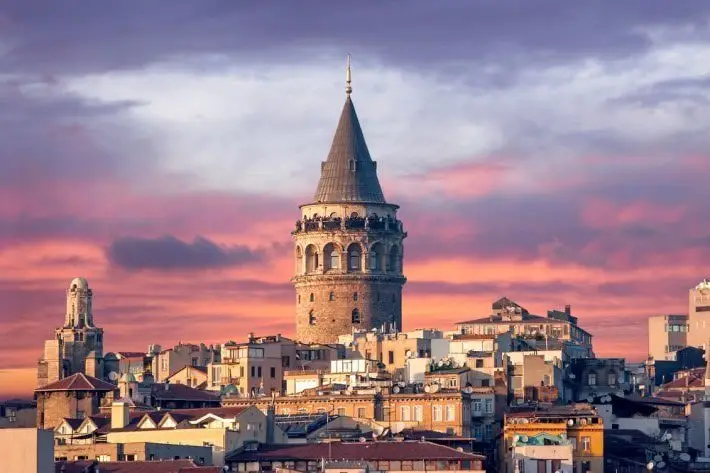Rising majestically above the skyline of Istanbul, the Galata Tower is one of the city’s most iconic landmarks, offering visitors a chance to step back in time while enjoying spectacular panoramic views. Whether you’re a history enthusiast, a photography lover, or simply someone who appreciates awe-inspiring vistas, the Galata Tower is an absolute must-visit when in Istanbul.
A Glimpse into History
The Galata Tower has a rich and varied history that spans over 600 years. Originally built in 1348 by the Genoese during their rule over the city as part of the fortifications of their trading colony, it was known as the Christea Turris or the “Tower of Christ.” Its purpose was to serve as a watchtower to protect the Galata district, which was an important commercial hub.
After the Ottoman Empire conquered Constantinople in 1453, the Galata Tower’s role shifted, and it became a part of the city’s expanding fortifications. Throughout the centuries, the tower has served various purposes, including as a prison, an observatory, and even a fire watchtower, due to its strategic position overlooking the Golden Horn, the Bosphorus, and the Sea of Marmara.
Architecture of the Galata Tower
Standing at 66.9 meters (219 feet) tall, the Galata Tower has an imposing presence that dominates the skyline of Istanbul’s historic district. The tower’s design is a stunning blend of medieval European and Ottoman architectural styles, with a cylindrical stone structure that tapers off toward the top, topped with a conical roof.
The tower’s base is made of large, weathered stone blocks, while its upper levels feature windows that allow for unobstructed views. The original wooden structure at the top was replaced in the 18th century by the current iron-and-wooden cone. The tower’s design is both simple and functional, serving as both a defensive fortification and a symbol of the city’s ever-evolving architectural landscape.
The Tower’s Various Roles Through History
Over the centuries, the Galata Tower has seen its fair share of uses:
-
Watchtower: As a watchtower during the Genoese period, the Galata Tower was strategically placed to defend the city from both land and sea. The tower’s height allowed its guards to spot potential invaders approaching the shores of the Bosphorus and the Golden Horn.
-
Prison: During the Ottoman era, the tower was repurposed as a prison. The tower’s isolated location and tall, imposing walls made it an ideal location for holding prisoners.
-
Observatory: In the 19th century, the Galata Tower took on a more scientific role. It became an observatory, where astronomers and scientists could study the stars and the skies, which were vital to the development of Ottoman science and navigation.
-
Fire Watchtower: Due to its height and strategic location, the Galata Tower was also used to keep watch for fires, which were a constant concern in the densely packed city of Istanbul. Fire watchmen would alert the population of any fires so that they could be extinguished before they spread.
The Tower’s Restoration and Modern Day
In the 1960s, the Galata Tower underwent significant restoration work, and it was re-opened to the public as a museum and tourist attraction. Today, the tower continues to be one of Istanbul’s most popular landmarks, drawing millions of visitors each year.
At the top of the tower, visitors can access an observation deck offering breathtaking panoramic views of the city. From here, you can enjoy a 360-degree view of Istanbul, with the Golden Horn, Bosphorus Strait, and the bustling streets of the Galata District below. On clear days, the view extends all the way to the distant islands and even the Asian side of Istanbul.
The Best Views in Istanbul
The Galata Tower offers one of the best vantage points in the city. Whether you’re admiring the vibrant lights of Istanbul at night or gazing out over the historic districts, the panoramic views are sure to leave you in awe. Here are some of the views you can enjoy from the tower:
-
Golden Horn: The Golden Horn is an inlet of the Bosphorus, separating the old city from the newer districts of Istanbul. The view from the tower showcases the lively waters of the inlet, with ferries, boats, and ships crossing frequently.
-
Bosphorus Strait: To the north, you can see the Bosphorus Strait, the body of water that separates the European and Asian sides of Istanbul. The view of the bustling waterway, with its ferries, bridges, and ships, is truly remarkable.
-
Historic Sultanahmet: To the south, you can see Sultanahmet, where many of Istanbul’s most famous landmarks are located, including the Blue Mosque, Hagia Sophia, and Topkapi Palace. The view provides a unique perspective of these grand structures.
-
Beyoglu: Directly below the tower is Beyoglu, the lively district where the Galata Tower stands. This bustling area is home to numerous cafes, restaurants, and shops, adding to the charm of Istanbul.
Visiting the Galata Tower
Opening Hours: The Galata Tower is open to visitors every day of the week, typically from 9:00 AM to 7:00 PM. However, it is recommended to check for any changes, as timings can vary due to maintenance or special events.
Ticket Information: Entrance to the tower requires a ticket. Prices vary depending on whether you’re an adult or student, and there may be discounts for children and seniors. It’s best to purchase tickets in advance to avoid long waiting lines, especially during peak tourist seasons.
Accessibility: The Galata Tower is located in the Galata district, easily accessible by foot, public transportation, or taxis. The nearest tram station is Karaköy, and the tower is a short walk from there. However, be prepared for some uphill walking as the tower is situated on a hill.
Dining at the Top
At the top of the tower, you’ll find a restaurant and café offering a chance to enjoy a meal or drink while taking in the views. The restaurant serves both Turkish and international cuisine, and the setting is perfect for a relaxed meal with an unforgettable backdrop.

